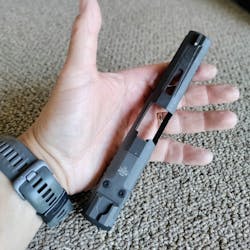The Armscor/RIA STK100: Optimum Aluminum
I tested the Armscor (Rock Island Armory) STK100, RIA’s first entry in the striker-fired 9mm arena. At the end of this test, I had a pile of brass, and a big smile.
The STK100 looks and operates like a Glock 17, only the frame is aluminum. Compared to the Glock, it has a grip angle similar to a 1911 handgun, and a more pronounced beavertail. It takes standard 17-round Glock magazines.
Most double stack, striker fired handguns are made of polymer. Polymer is less expensive, and it is molded, not milled. Armscor manufactured the aluminum frame by milling separate halves of the frame. After, they mated the clamshell halves together with recessed screws. The resulting frame feels solid in the hand, and frame features can be manufactured with a precision that can only be expected from the rigid quality of aluminum.
This is the first noticeable thing about the STK100. Glocks are precision manufactured, but the polymer material has a natural “give,” which is part of the polymer appeal. It almost feels like the material softens the harshness of the shooting experience. The STK100 aluminum body feels like more of a precision instrument, as if someone had taken all of the play out the working parts. Since the STK100 had more frame contact on the slide than most other guns, and aluminum machines with more precision than polymer can mold, there was little play in assembled parts.The slide looks like a Glock 17 slide. However, it has 3 parallel lightening cuts in the front, and a narrow milled section where these cuts reside. The parts are interchangeable with Glock parts, mostly. The slide is made from 4140 hydrated steel, with a matte Parkerized finish.
What do these cuts do? Part of the recoil impulse is the heavy slide slamming backward on the frame, where it is stopped abruptly by its mechanical limits. After it slams backward, it slams forward until it reaches its forward mechanical limits we commonly call “in battery.” Since the slide has mass of its own, this part of the shooting cycle is also felt by the shooter. Lightening the slide often reduces felt recoil, depending on how the slide is managed by spring power and dampening.
If one were to take their own slide to a gunsmith for this kind of milling work, or purchase an aftermarket slide with the standard features of the STK100, the price would easily be twice to three times the price of this firearm. Not only that, my tests concluded that the STK100 runs this configuration reliably, without having a custom tuning job.
The STK100
How did the gun feel with the lightened front end of the slide? Futuristic. The lengthened beavertail adds to the handling characteristics. It not only made the gun easier to steer, it really distributed the recoil impulse.
I swear, if I was a kid again, I would have learned the shooting sound as, “Zing, zing!” instead of “Bang, bang,” just because of the slick motion of the slide on this frame.
Since most aftermarket Glock slides will mount on this gun, a competitive shooter would have a pretty broad array of options.
The gun soaked up recoil very well, and the recoil impulse felt like it was right on the axis of the bore. Of course it was! Because the construction, it had mass where a Glock was normally hollow. In terms of physics, the STK100 had its mass concentrated in places that made it more recoil resistant.
The receiver has milled, stippled sections on the grip flats, and lines in the front strap and backstrap. The beavertail extends past the rear of the slide, which is much further than the original Glock. Since my first assigned handgun was an M1911, the grip was as natural as it could be for me.Glock enthusiasts should know that better than 90% of the STK parts are either interchangeable, or swappable with a little modification between the two guns. I can already picture these popping up on our ranges with bright triggers, Thin Blue Line slide covers, and pink slide stop releases.
The STK100 is optics ready, in a very original way. There is a fixed rear sight milled into the optic cut. When the user removes the plate to add an optic, the rear sight goes away too. I would prefer a method that allowed for a rear sight and an optic, but this is a great set up. The rear sight is flat black, if one leaves the optic cover on.
The front sight is Glock compatible, which means every aftermarket sight in the industry will fit it. It is a good thing, too. The original equipment is a thin front sight blade, which I would replace with a good bright one right away.
We had a couple of good shooting sessions with the STK100. It points naturally, and, although it is still moderately light for a duty gun, it has enough mass for keeping two, and sometimes three ejected brass in the air, while still punching center mass on the target. It also comfortably fit a variety of hand sizes.
Consider this: If a person wished to customize the configuration of the grip of the gun, it would be done by milling, not melting. The potential for doing this is very high. A few years ago, I would have my badge laser engraved on the flats of the grip.I had my friend, former MLB pitcher Doug Fister, shoot this gun, and the nearly complete lack of muzzle flip and quick follow up shots was encouraging. Doug is a foot taller than me, and his hands are bigger. Not only did he ease into throwing lead with this gun, the bullets actually travelled faster than his pitches.
Although the STK100 is very close in size and dimensions to a Glock 17, there is absolutely no guarantee it will fit the same holsters. In fact, I would wait until a holster manufacturer made a specific fit. Since the new holster paradigm is agile manufacturing, I’m certain several manufacturers are eying the current success of the STK100, and considering this fit.Would I use the STK100 for duty? It is a familiar operating system, with a parts and aftermarket inventory that is as vast as any other firearm product besides a Ruger 10-22. It is from a no-nonsense company whose customer support is well known among their fan base. RIA is also known for getting lots of feedback from their customer base, and their shooting athletes, of which there are several on staff. For example, John McClain, their Sales Manager and Training Manager, is also a pro shooter. Actually, it seems like almost everyone at RIA is a competitive shooter.
In many respects, the STK100 is an improvement on the Glock platform. I think the STK100 is worth a look. I expect that, over the next year or so, RIA will probably release a G19 sized STK, or something similar.
The MSRP is $599. If this price is consistent with what we know about RIA/Armscor, it will be cheaper on the shelves. For the standard features, the price tag could be a lot higher, and it would be worth it.
About the Author

Officer Lindsey Bertomen (ret.), Contributing Editor
Lindsey Bertomen is a retired police officer and retired military small arms trainer. He teaches criminal justice at Hartnell College in Salinas, California, where serves as a POST administrator and firearms instructor. He also teaches civilian firearms classes, enjoys fly fishing, martial arts, and mountain biking. His articles have appeared in print and online for over two decades.




